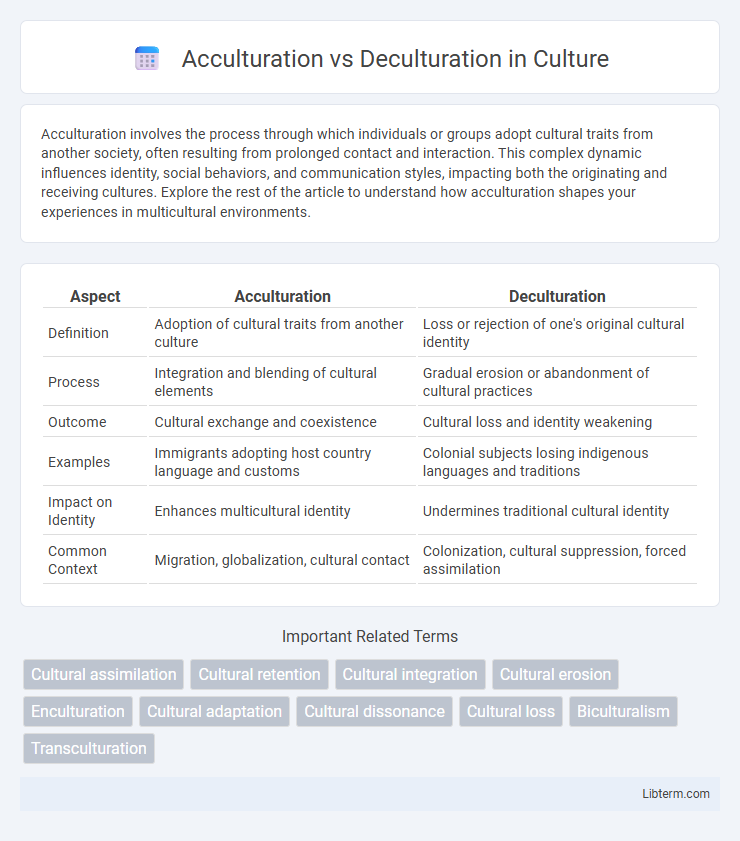Acculturation involves the process through which individuals or groups adopt cultural traits from another society, often resulting from prolonged contact and interaction. This complex dynamic influences identity, social behaviors, and communication styles, impacting both the originating and receiving cultures. Explore the rest of the article to understand how acculturation shapes your experiences in multicultural environments.
Table of Comparison
| Aspect | Acculturation | Deculturation |
|---|---|---|
| Definition | Adoption of cultural traits from another culture | Loss or rejection of one's original cultural identity |
| Process | Integration and blending of cultural elements | Gradual erosion or abandonment of cultural practices |
| Outcome | Cultural exchange and coexistence | Cultural loss and identity weakening |
| Examples | Immigrants adopting host country language and customs | Colonial subjects losing indigenous languages and traditions |
| Impact on Identity | Enhances multicultural identity | Undermines traditional cultural identity |
| Common Context | Migration, globalization, cultural contact | Colonization, cultural suppression, forced assimilation |
Understanding Acculturation: Definition and Process
Acculturation refers to the process by which individuals or groups adopt cultural traits or social patterns from another culture, often occurring through prolonged contact. This dynamic interaction involves changes in language, customs, values, and behaviors while maintaining elements of the original culture. Understanding acculturation is essential for analyzing how cultural integration, adaptation, and identity transformation take place in multicultural societies.
What is Deculturation? Key Concepts Explained
Deculturation is the process through which individuals or groups lose their original cultural traits, often due to prolonged exposure to another dominant culture. Key concepts include cultural erosion, identity loss, and assimilation pressures that diminish traditional customs, language, and social practices. This phenomenon frequently occurs in contexts of colonization, migration, or globalization, where original cultural frameworks become displaced or replaced.
Historical Overview: Acculturation and Deculturation in Context
Acculturation and deculturation are pivotal concepts in understanding cultural transformation throughout history, where acculturation refers to the process by which one culture adopts elements of another culture, often seen during colonization and migration periods. Deculturation involves the loss or abandonment of a native culture due to external influences, frequently occurring under imperial domination or forced assimilation policies. Historical examples include the blending of Native American and European cultures during colonization (acculturation) and the systematic erasure of indigenous languages and traditions in residential schools (deculturation).
Core Differences: Acculturation vs. Deculturation
Acculturation involves the process where individuals or groups adopt cultural traits or social patterns from another culture, leading to cultural blending or integration. Deculturation refers to the loss or displacement of one's original cultural identity due to external influences or dominance of another culture. The core difference lies in acculturation fostering cultural adaptation and synthesis, while deculturation results in cultural erosion or abandonment.
Psychological Impact of Acculturation
Acculturation influences psychological well-being by shaping identity, stress levels, and social integration among individuals adapting to a new culture. Research highlights increased risks of anxiety, depression, and identity confusion during acculturation due to cultural conflicts and discrimination. Protective factors such as social support, cultural competence, and bicultural identity contribute to positive psychological outcomes and resilience.
Social Consequences of Deculturation
Deculturation leads to social fragmentation as individuals lose connection with their cultural heritage, resulting in identity confusion and diminished community cohesion. This process often causes marginalized groups to experience social exclusion, reduced intergenerational communication, and weakened social networks. The loss of traditional cultural practices can undermine social support systems, increasing vulnerability to mental health issues and social alienation.
Factors Influencing Acculturation and Deculturation
Acculturation and deculturation are influenced by factors such as the degree of cultural similarity, social support systems, and the individual's openness to new experiences. Socioeconomic status and exposure to dominant cultural norms also play critical roles in determining the ease and extent of cultural adaptation or erosion. Language proficiency and community integration significantly impact the balance between adopting new cultural traits and losing original cultural identities.
Real-World Examples: Cultures in Transition
Acculturation occurs when immigrants in the United States adopt American customs, such as language and dress, while maintaining elements of their native culture, exemplifying cultural blending in urban centers like New York City. Deculturation is evident in indigenous communities, such as Native American tribes, where traditional practices are lost due to historical policies like forced assimilation and boarding schools. These processes highlight the dynamic nature of cultures in transition, influenced by factors like globalization, migration, and government interventions.
Strategies for Navigating Cultural Change
Strategies for navigating cultural change involve balancing acculturation, which integrates new cultural elements, with deculturation, the loss of original cultural traits. Adaptive approaches like cultural assimilation, integration, separation, and marginalization define how individuals or groups handle cultural interaction. Emphasizing cultural competence and open communication facilitates smoother transitions while preserving essential identity elements amidst cultural shifts.
Future Trends: The Evolving Nature of Cultural Adaptation
Future trends in acculturation and deculturation highlight increasing cultural hybridity driven by global digital connectivity and migration patterns. Emerging technologies and virtual environments facilitate continuous cultural exchange, accelerating adaptation while challenging traditional cultural boundaries. Predictive models suggest growing emphasis on dynamic, bidirectional cultural influence rather than unidirectional assimilation or loss.
Acculturation Infographic

 libterm.com
libterm.com